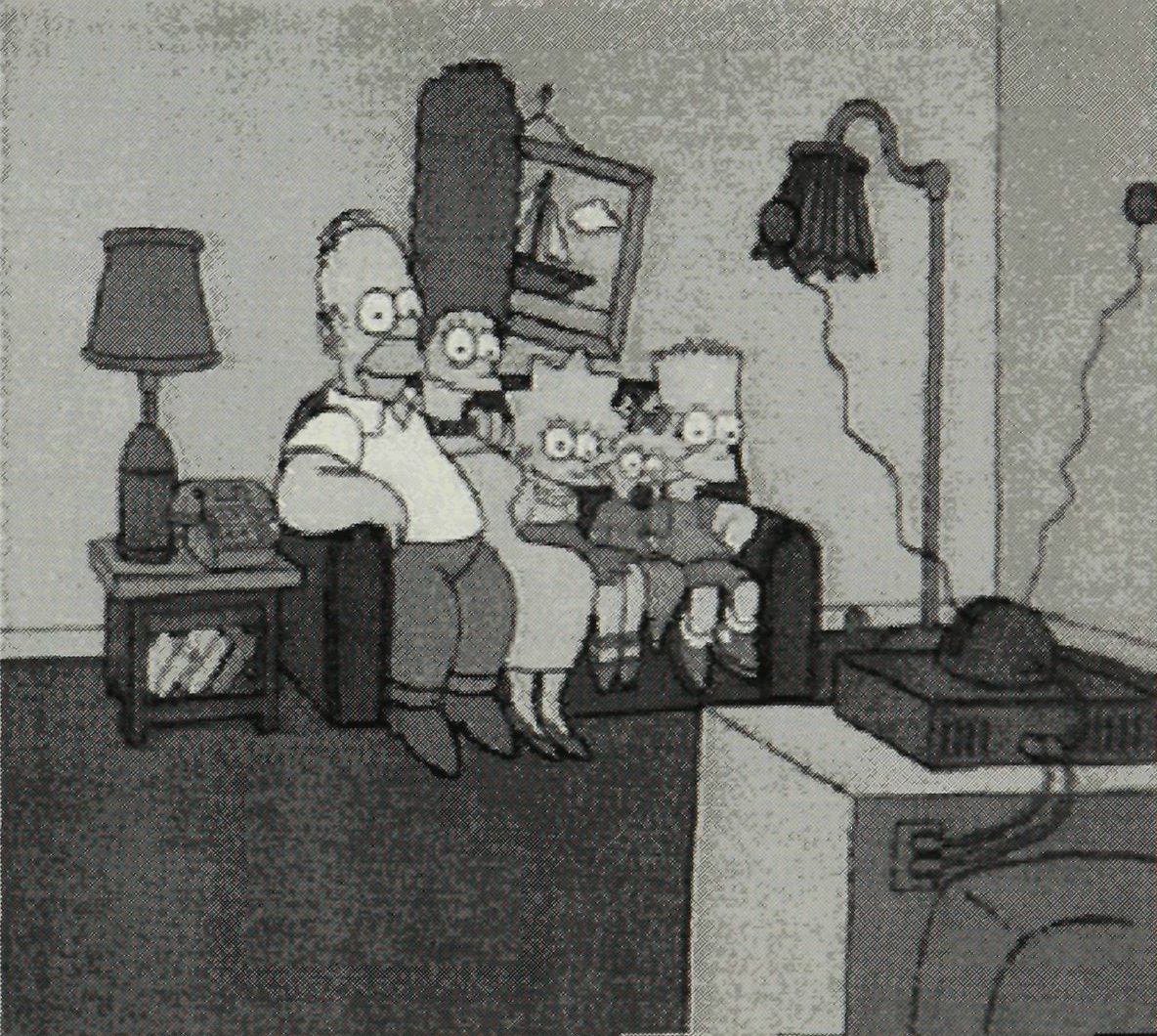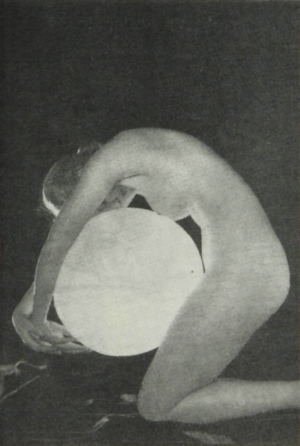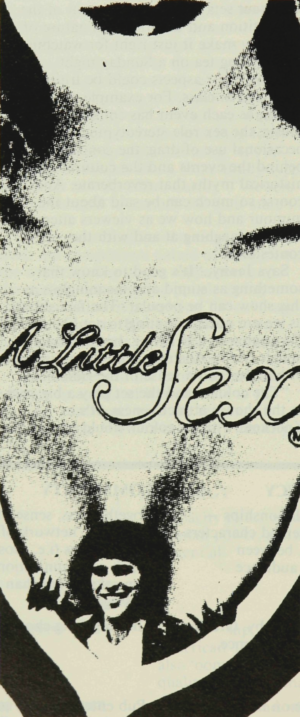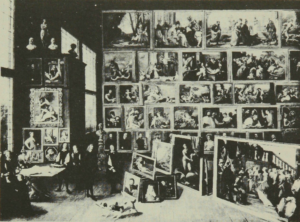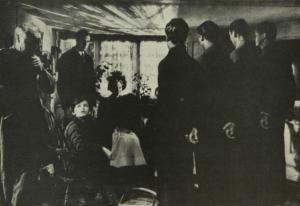In the 1992 U.S. elections, George Bush declared that he wanted the American family to be more like The Waltons and less like The Simpsons. Two things struck me about this statement. The first was that the relationship between the mass media and the political process is reaching a very complicated stage in the United States when the President makes a central plank of his platform the desire to make American families less like a group of cartoon characters. The second was that The Simpsons must be a significant site of political contestation in American culture.
When Bart Simpson responded[1]The thought of “Bart Simpson” responding to a campaign speech of the US President is itself intriguing. to Bush by saying “Hey, we’re just like The Waltons. We’re an American family trying to survive the Great Depression”, I was reminded of why I am a fan of the show. It epitomised all that is fun and cheeky, yet also dark and subversive, about the show. It was a reminder of what it meant for TV culture, and for commentary about American society, when The Simpsons was the first show for a long time to outrate The Cosby Show, where the upwardly-mobile Huxtable family had dominated the U.S. sitcom ratings for almost a decade. It was the transition from the 1980s to the 1990s. I could understand writer Bob Ellis’ enthusiasm for the show when he commented that “it’s so good to see Marxism alive and well and rating on American television”.[2]“Portrait of an Anti-Hero”, The Australian, 18–19 September 1993.
It was thus surprising to find Gary MacLennan describe The Simpsons as a show based upon “the middle class myth of the reactionary working class totally supporting the aims of the ruling class”.[3]Gary MacLennan, “Class in Contemporary Popular Culture’, Metro No. 96, Summer 1993/4. Even allowing for the idea that popular cultural texts are open to a range of potential readings, this seems a particularly misleading and unhelpful interpretation of the show. It not only fails to clarify what it is about the program that “works” – it has, after all, rated highly in most countries in which it has been screened – but also provides a curious and somewhat atavistic interpretation of the concept of class in contemporary popular culture. I will elaborate upon these points briefly, before considering in more detail some aspects of the show and implications an analysis of it may present for the teaching of media studies.
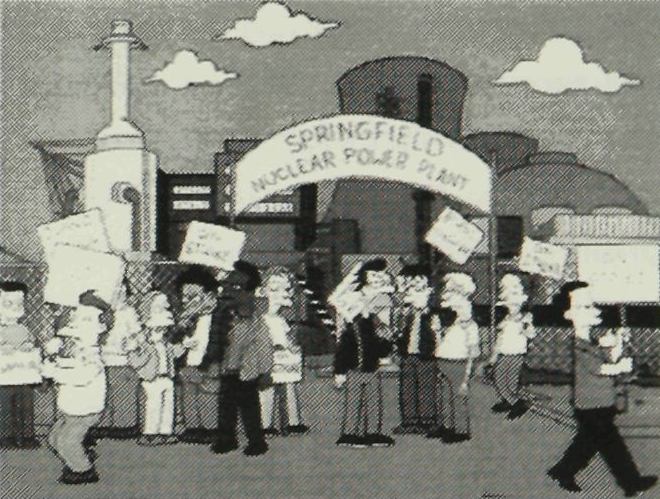
The important point which MacLennan does recognise in The Simpsons is that it clearly foregrounds issues of class. Through the character of Homer Simpson, we are presented with a structural analysis of class in American society: Homer has a dead-end job in the nuclear power plant, few prospects, little job security or satisfaction, and a vindictive and tyrannical boss. Unlike most television programs, where the main characters are either self-employed, work in a co-operative and egalitarian work environment, or where work is never an issue, class relations in the workplace are central to the show. We know who the bosses and the workers are. The episode which MacLennan discusses, where the nuclear plant boss Burns runs for Governor to halt an enquiry into why a three-eyed fish was caught by Bart in a river near the plant, neatly encapsulates the manner in which the dynamics of class power work through the show. Another episode which I will discuss below, where Homer leads the plant workers on a strike against Burns’ moves to abolish their dental plan, indicates a capacity for resistance which MacLennan’s one-dimensional presentation of class and ideology in the show neglects.
We also are presented with the Simpson family as being working class in a cultural sense. They eat meat loaf, watch tenpin bowling on TV, go to truck races, and have trouble making ends meet. It is important to emphasise here that the viewer “knows” that the Simpsons are working class, not because viewers have a thorough knowledge of the cultural habits of the American working class, but because they are represented to us as working class through our knowledge as viewers of American working class sitcom families. Through the Simpsons, we can trace a genealogy of representation which includes Roseanne and her family, Archie and Enid Bunker from All in the Family, Fred and Wilma Flintstone, and the founders of this tradition, Ralph and Alice from The Honeymooners. Even if these traces do not resonate with the viewer, as they would not with many young viewers of the show, we can recognise the Simpsons as working class by comparing them to their neighbours: the god-fearing, middle class, punctilious and thoroughly tedious Flanders family. If kids like Bart have an attitude problem, it may be in part because they recognise the Flanders children as representing that to which they cannot aspire, as the literature on class socialisation has often noted.
This is far too pessimistic a reading of the fate of the Simpson family. In fact, the show is often based around how they, a relatively powerless group, can win “small victories” over the more powerful. But it is an important corrective to the notion that The Simpsons misrepresents the nature of the working class. Perhaps it does, in that it presents “class” through a set of mediated cultural and televisual codes (eating meat loaf, watching tenpin bowling, being bored and dissatisfied with one’s job, hating school) that viewers understand, whether or not it holds to actual working class experience, however that may be defined or characterised. It may not, however, in the sense that MacLennan’s criticism [4]MacLennan, op. cit., p. 47 of the conclusion to the three-eyed fish episode that the working class (Homer) played no role in the defeat of the owning class (Burns) may in fact be closer to the money than he would like to admit. Michel Foucault has pointed out repeatedly that power operates through, rather than over, populations,[5]Michel Foucault, “Film and Popular Memory” in Foucault Live (New York: Semiotext 1989). and in the U.S. the success of the Republican Party in the 1980s was built upon the votes of the “Reagan Democrats” – sections of the white working-class male population in a political context where the white American working class has typically channelled all its industrial energies into higher pay for their jobs, rather than challenging the distribution of power in the workplace.[6]Mike Davis, “Why the US Working Class is Different”, New Left Review, No. 124, July/August 1984. Indeed, in the Bush/Simpsons exchange discussed earlier, Homer’s response was to dumbfoundedly plead that he “voted for that guy last time”.
The Simpsons can of course be read in a lot of different ways. Homer Simpson can be read as a travesty of the working class (as MacLennan reads him), as a mediocre father-figure (as children may read him), as a dumb white guy (as minority audiences may read him), and as a dumb male vastly inferior to Marge and Lisa (feminist readings). He may represent the crisis of patriarchal authority, the limit-point of the suburban consumerist utopia, the negation of all those wise father figures from the Dad in My Three Sons to Cosby, or the crisis of the traditional working class in deindustrialising and socially polarising post-Fordist America. He is also one of the great comic creations of American popular culture.

It is wrong to say that Homer is blasé about American consumer culture. He is in fact positively euphoric about every pleasure it alleges to offer, seeking a kind of jouissance from everything from Duff Beer to baldness cures, from bowling balls to new running shoes, pizzas and theme parks. There is no Utopian possibility Homer cannot conceive having access to if only he had access to the right commodity. A limitless desire to consume without producing. A marketer’s dream. Willy Loman without the work ethic. As a result he is overweight, drinks too much, watches too much TV, is grouchy with his family, and is in imminent danger of a heart attack.
The rest of the Simpson clan share Homer’s enthusiasms to a lesser extent, but can see the limits of Homer’s hedonism. Marge is in the most obvious dilemma. A talented and intelligent young woman with a developing feminist consciousness, she has made the mistake – as her sisters continually remind her – of marrying below her potential social position, and is now grimly determined to hold the family together, even if at considerable personal cost. In many episodes, however, Marge draws a clear line of what is no longer acceptable, and in one episode considered having an affair with a gigolo from the bowling alley in order to spite Homer.
Bart and Lisa present an intriguing set of possibilities. Bart could very easily go the way of his father, yet he is also acutely aware of the limitations of his dad as a role model for adult male life. Although he likes Homer, he holds little of the respect for him that could once upon a time be taken for granted from children in TV sitcoms. Bart’s ethos is one of survival in the here-and-now, from the likes of his schoolteachers, the school bullies, and occasionally the police: he will confront the future when it comes. Lisa is perhaps the show’s most complex character.
A naturally gifted child, her skills – as a student and as a musician – are continually being thwarted by her father’s negligence, the teachers’ demand to conform, the disruptive antics of her brother, and her anxieties about her looks and her popularity. About Maggie we know little, except that she has seen far too much for a 6-month-old child.
The Simpsons works brilliantly as children’s television, and it is not hard to see why. Unlike many officially-sanctioned children’s shows, which continually remind children of their subordinate status to adults, The Simpsons presents its adult characters as childlike creatures. It constitutes the “blurring of childhood and adulthood” that Joshua Meyrowitz has described as characteristic of a TV-dominated culture where there are no longer spaces where adult behaviour can be kept from children, and socialisation into the norms and literacies of the culture can no longer be kept to the incremental gradations possible in a print-dominated era.[7]Joshua Meyrowitz, No Sense of Place, 1986: Ch. 13. At the same time, it presents the adult world as threatening, yet impossible to escape from. Virtually all of the adult characters in the show – Burns and his assistant Smithers, Marge’s sisters, Principal Skinner, the police, Moe the barman, psychopathic babysitters, dentists, the local Minister, Mayor Quimby – present threats to Bart and Lisa, as they often do to Marge and Homer. Perhaps the only non-threatening character to the children is Homer’s father, whose advanced years are seen as having reduced him to a thoroughly childlike status. Rather than presenting a world where “God does indeed look after drunks, little children and the USA”,[8]MacLennan, op. cit., p. 47 Springfield presents a world where narrative closure is very provisional indeed, and threats are deferred rather than eliminated.
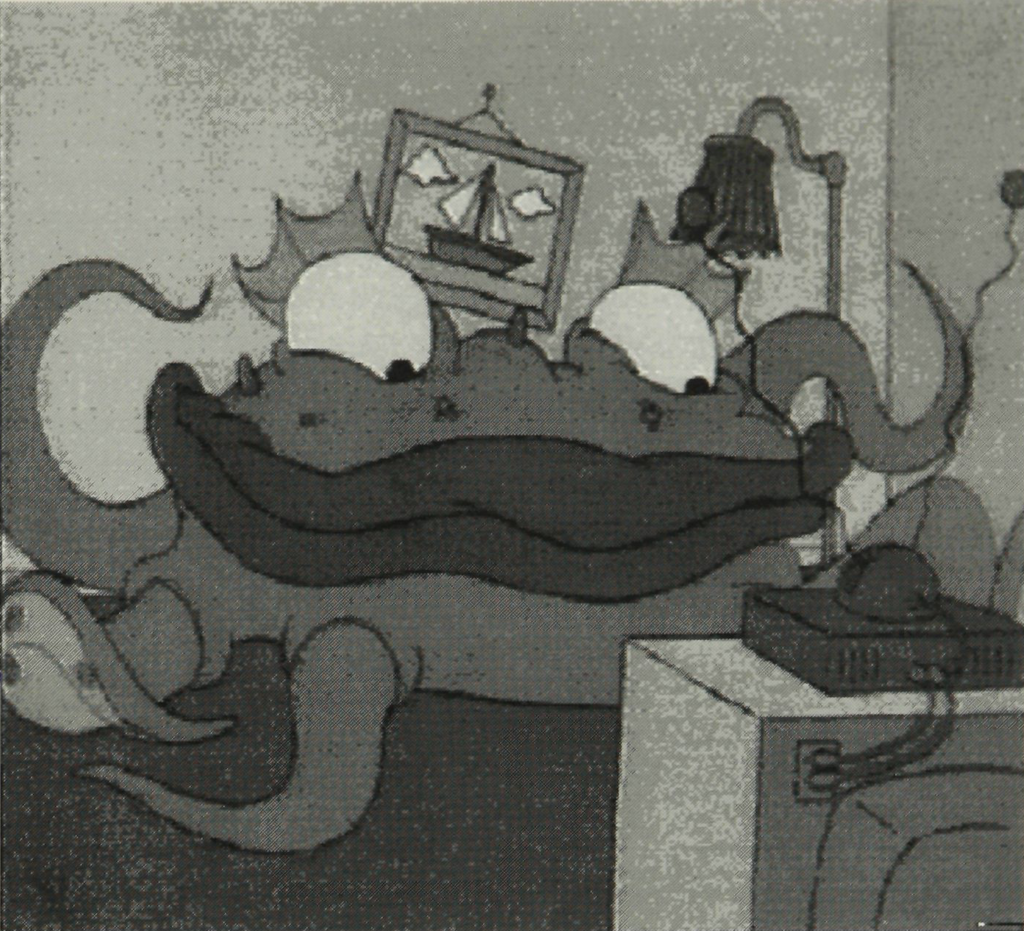
The other thing that The Simpsons is about is of course television. It is literally a TV show about characters who watch too much television. The famous opening credits to the show perhaps illustrate this best. As McKenzie Wark has observed, the opening is a take on The Flintstones –
“the modern stone age family” who raced off to the drive-in – with a postmodern twist.[9]McKenzie Wark, “Homer’s Odyssey”, 21.C No. 8, Summer 1992. The opening presents the family members racing from various oppressive public environments (work for Homer, school detention for Bart, music classes for Lisa, and shopping for Marge and Maggie) to the apparent sanctity of home, where they can sit on the couch and watch TV. Upon arriving home, however, something always happens; the couch eats them, someone falls off, a circus begins in the lounge room, they fall through the floor. The critical space for the Simpsons is the “virtual space” between themselves and the TV screen; it socialises the children and it constitutes the “outside world” and their means of interpreting it.[10]Mary Ann Doane has drawn attention to the importance and the interchangeability of the “virtual spaces” of the freeway, the shopping mall and television, as crucially formative of subjectivity in modern urban culture. Mary Ann Doane, “An Ontology of Everyday Distraction: The Freeway, the Mall and Television”, in Patricia Mellencamp (ed.), Logics of Television (Bloomington: Indiana Univ. Press 1990). This is, moreover, a world of multichannel cable TV, with its often obscure mix of home shopping programs, Mexican sitcoms and “reality television”.
The Simpsons is a deeply intertextual program. Its scriptwriters know that its viewers have watched a lot of television, and it offers a treasure-trove of signifiers and referents from other popular cultural texts, which its viewers can observe on the basis of the cultural competencies they have acquired through television and other forms of popular culture. Sometimes these references are obvious, as with the cartoon show Itchy and Scratchy, an ultra-violent parody of the Tom and Jerry cartoons,[11]Paul Keating’s campaign in 1992 for the TV networks to introduce tighter program classification standards resulted from his watching this cartoon with his children on a Sunday evening. or the parody of TV news anchormen presented by Kent Brockman on the “Smartline” program. Others, such as Principal Skinner’s occasional bitter diatribes about how the Government sold out soldiers like himself in the Vietnam War, are less obvious. And then there are the downright obscure references beloved by cultural studies academics and others who spent too much time on computer bulletin-boards, such as the fact that Marge’s maiden name (Bouvier) is also that of Jackie Kennedy Onassis, or the way in which the family doctor is based upon Bill Cosby’s Cliff Huxtable character. The show is also deeply aware of itself and its own place in contemporary culture, and is seen by some writers as characteristic of “postmodern” television.[12]Jim Collins, “Television and Postmodernism”, in Robert Allen (ed.), Channels of Discourse, Reassembled (London: Routledge 1992).
The episode I wish to consider in detail begins with such a reference, with Homer and Bart watching a video where a fiendish plot to put a new “smart drug” on the market is foiled by the action hero McBain (complete with cropped blond hair, huge muscles and ludicrous mock-German accent), who emerges out of an ice sculpture and proceeds to shoot everyone at the table except the villain who poisons him with a salmon puff. As the villain cackles maniacally, Bart turns to Homer in a concerned way, but is assured that no-one in the real world could be that bad. There is then a cut to Burns maniacally cackling about the disappearance of the union representative, who has in fact been buried on a football field. Burns is considering renegotiating the union contract with the workers, and reminiscing about how his grandfather maltreated workers at the turn of the century, before unions were formed. Inspired by this memory, he vows to take back the dental plan from the nuclear power workforce.

The plot then moves to the dental surgery, where a tyrannical dentist threatens the children. He explains to Marge that Lisa needs braces, and uses a computer simulator to show that, without braces, she will turn into what Bart helpfully terms “a freak”. Marge and the children return home to tell Homer of this, who reassures her that, with the dental plan won during the last strike, they will not be affected. He then attends the union meeting, where Burns’ contract, which proposes abolishing the dental plan for a free keg of beer at union meetings, is accepted. While waiting for a beer, Homer ponders the connection between the dental plan and Lisa needing braces, before realising that if the dental plan is abolished, then they cannot afford Lisa’s braces. He becomes union representative and begins negotiations with Burns.
Negotiations with Burns are unsuccessful, since on the first occasion Homer believes Burns is trying to seduce him, and on the second (after Homer is taken away by hired goons), his need to go to the toilet is taken as rejection. Meanwhile, Lisa has received a hideous set of braces, as this was all that could be afforded without coverage under a dental plan. Homer leads the workers into a strike, and they picket the nuclear power plant, as Lisa sings a song about the strike with the lines “So we’ll march day and night by the big cooling tower. They have the plant, but we have the power.” After Burns and his assistant Smithers attempt unsuccessfully to run the plant themselves, Burns, Homer and “chat-show mainstay Dr. Joyce Brothers” appear on the program Smartline to discuss the strike. After host Kent Brockman introduces Homer as a “union kingpin” and asks him whether trade unions are “lumbering dinosaurs”, Brockman informs Homer that the producer has told him not to talk to him any more.
Burns then shuts off power to the city, leading to widespread looting, but this does not deter the strikers, who join hands outside the plant and sing the song with Lisa. At this point Burns offers Homer a deal, where the dental plan is retained as long as Homer steps down as union rep. As Homer dances on the carpet making chicken noises, Burns muses that perhaps Homer “wasn’t the brilliant tactician he thought”. The show ends with Lisa getting new braces and telling a joke at the dental surgery which causes everyone to laugh, the dentist realising the gas has been left on, and everyone continues laughing.
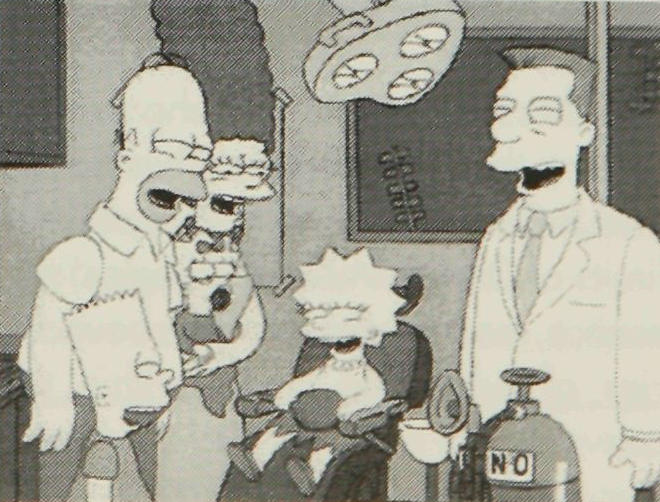
The episode captures a number of the aspects of The Simpsons which make it an interesting, unusual and even provocative show. While some may complain about how unions and workers are represented at some points, with references to links to organised crime and a general herd mentality pervading the union meetings, it is unusual in the context of American television that unions are represented at all, and are presented as necessary organisations with legitimate grievances against rapacious employers. Further, the show makes clear the extent to which employers will go in breaking strikes, including bribery, thuggery and blackmail of the general public. Most interestingly, the show also makes it clear that the mass media is very clearly biased towards the interests of the employer in such instances.
Elements of the show’s intertextuality are also to be found in this episode. As well as the reference to Schwarzenegger films and the comment on late-night news programs, there are also allusions drawn to 60s TV shows such as Get Smart and Batman, to the more recent Batman films, and to psychedelia such as the Beatles’ Yellow Submarine cartoon film. The episode also refers to the program itself, blurring the reality/fiction line and presenting episodes as if they occur in real time and in real places. At one point, when Burns is trying to remember who Homer Simpson is, Smithers reminds him that Homer supported his campaign for Governor, saved the plant from meltdown, that Burns ran over his son, and that Homer’s wife painted him in the nude, referring to plotlines in previous episodes.
It must be said that The Simpsons poses a challenge for the dominant models of media studies. MacLennan’s class-based critique presumably draws its inspiration from the observation made by Noam Chomsky, Herb Schiller and others that the mass media are controlled by major corporations, and that they present an ideological world-view that is consistent with their own corporate interests. [13]Noam Chomsky and Edward Herman, Manufacturing Consent (New York: Pantheon 1988); Herbert Schiller, Information and the Crisis Economy (Norwood: Ablex 1984). Yet I have indicated that The Simpsons cannot be adequately understood in terms of this model of ideological control. Indeed, it may well present a view of the world which is at odds with the dominant corporate interests.
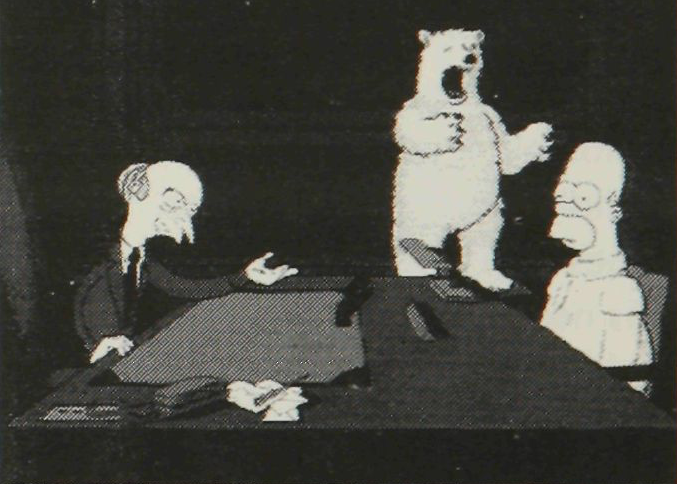
The problem The Simpsons presents for the “industrial” approach is the difficulty it faces in reconciling the idea of a program with a subversive, almost leftist bent, with its being a cultural flagship of Rupert Murdoch’s global media empire, centred on his FOX Network in the U.S.. It provides an interesting mix of the radical and the popular, yet it owes its existence to the marketing strategy of the best known conservative media baron in the English-speaking world. Murdoch has himself commented on the irony of this in interviews, arguing that The Simpsons does not present the world as he sees it, but adding that you have to admit it is funny. Perhaps more importantly, from Murdoch’s point of view, it also rates, and thus attracts advertising revenue to his networks.
The irony is that there is no problem in reconciling this apparent contradiction, as long as it is recognised that, for Murdoch, political concerns are clearly subordinate to the organisation’s profitability. In the U.S., the key to FOX’s strategy to become the fourth national free-to-air broadcaster, and to win audiences from the powerful “Big Three” U.S. networks, was to target audiences under 25, considered by advertisers to be a desirable demographic group to capture, but generally shunned by the major commercial networks, who feared that programs appealing to this group would be alienating to older audience groupings. In Australia, the TEN network runs it at 6 pm against the news programs, gambling on the observation that at that time of evening, children often dictate the family’s viewing patterns, at least in one-TV households.

At first glance, approaches derived from textual studies should be able to provide greater insights into The Simpsons. The show is intensely televisual, appropriating recognisable elements from the whole history of film and television, as well as constantly referring back to its own status and history. It also has programs and cartoons within its own cartoon program, and has at times presented itself as the centre of debates about television. The classic instance of this was the episode where Marge Simpson took up a protest against excessive TV violence after seeing Itchy and Scratchy and its effects on young Maggie’s behaviour.
The Simpsons is therefore very much suitable to analyses of media texts which stress bricolage, intertextuality and the scope for a plurality of readings on the part of differently-situated television audiences.[14]e.g. John Fiske, Television Culture (London: Routledge 1987). Yet the point about The Simpsons is that these are not “aberrant decodings” which contrast to a “preferred reading” of the text, but are in fact the preferred reading the producers themselves have constructed. This is not to say that different audiences will not read the show differently, but rather to draw attention to the element of auteurism in the program’s construction, where the producers offer the viewer the opportunity of a kind of postmodern treasure hunt, rifling through the show for elements of pastiche, irony and intertextuality.[15]A similar process can be found in the rock band U2’s “ZOO TV” concerts and videos, which compel the viewer to “become postmodern” in order to comprehend the presentation. See Terry Flew and Stephanie Pfennigwerth, “Theory Will Eat Itself”, Metro, No. 95, Spring 1993. This has the added advantage, to return to industrial considerations, of giving the show an appeal which goes beyond its target pre-teen audience to embrace older viewers, not least students and teachers of media studies, cultural studies and postmodernism!
The Simpsons have been described as the “postmodern nuclear family”.[16]Wark, op. cit. The blurring of lines between culture and its forms of representation, its textual strategies, and the idea of the American dream gone awry all point in such directions. Yet The Simpsons does not come from the Baudrillardian school of postmodernism which sees society, meaning and ethics as having imploded into a “black hole” with the dominance of the mass media.[17]e.g. Jean Baudrillard, “The Masses: The Implosion of the Social in the Media” in Mark Poster (ed.), Jean Baudrillard: Selected Writings (Cambridge: Polity Press 1992). The show is in fact very much concerned with questions of ethics and justice, albeit in a quite different way to their usual treatment in American situation comedy. Interestingly, a recent survey of primary school children found that they considered The Simpsons to be the most realistic program on TV after the news.[18]Susan Howard, “How Real Is Television: Modality Judgements of Young Children”, Media Information Australia No. 70, November 1993.
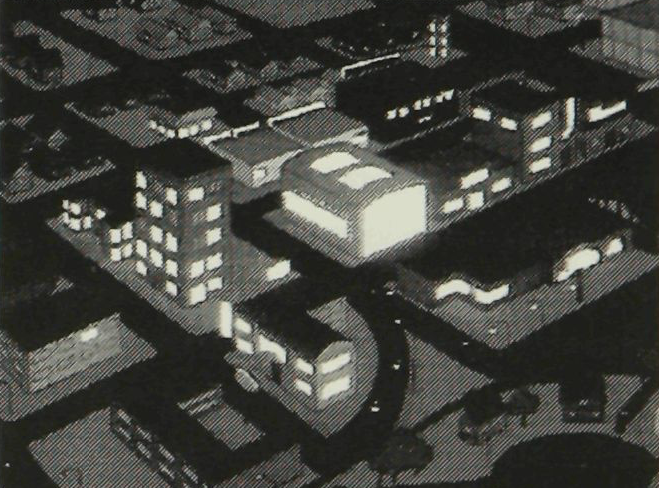
A useful framework for understanding the ways in which power and resistance operate through The Simpsons comes from Michel de Certeau’s notion of “making do” in everyday life, and the ways in which the “power of the weak” can manifest themselves.[19]Michel de Certeau, The Practice of Everyday Life (Berkeley: Univ. of California Press 1984). The Simpson family, and particularly Bart and Lisa, are presented as having to deal with power structures, technologies, economic forces and mediascapes which are beyond their overall control, but where they can achieve small victories on the run, like Homer’s successful resolution of the strike against the odds in the episode discussed above. As de Certeau notes, however, these are gains which can only be savoured briefly by the less powerful, just as the poaching of fragments of the discourse of The Simpsons by its fans remain a murmur, barely audible, but loud enough to have discomforted both American Presidents and Australian Prime Ministers.
While this is not the great clash of conflicting forces which some media analysts are seeking from popular television, The Simpsons provides a cultural mud-map to suburban life from the bottom up, and an ingenious piece of subversive comedy from within the belly of the beast of prime-time network television. It also illustrates the considerable possibilities for social commentary, and for the presentation of ways of thinking otherwise, arising from what was thought to be the most banal of genres, children’s cartoon comedy. In terms of the “practical tasks of education” about media and society, The Simpsons provides an excellent program to analyse in some detail, both for “how it works” as television, and “what it says” about contemporary society and culture.
Endnotes
| 1 | The thought of “Bart Simpson” responding to a campaign speech of the US President is itself intriguing. |
|---|---|
| 2 | “Portrait of an Anti-Hero”, The Australian, 18–19 September 1993. |
| 3 | Gary MacLennan, “Class in Contemporary Popular Culture’, Metro No. 96, Summer 1993/4. |
| 4 | MacLennan, op. cit., p. 47 |
| 5 | Michel Foucault, “Film and Popular Memory” in Foucault Live (New York: Semiotext 1989). |
| 6 | Mike Davis, “Why the US Working Class is Different”, New Left Review, No. 124, July/August 1984. |
| 7 | Joshua Meyrowitz, No Sense of Place, 1986: Ch. 13. |
| 8 | MacLennan, op. cit., p. 47 |
| 9 | McKenzie Wark, “Homer’s Odyssey”, 21.C No. 8, Summer 1992. |
| 10 | Mary Ann Doane has drawn attention to the importance and the interchangeability of the “virtual spaces” of the freeway, the shopping mall and television, as crucially formative of subjectivity in modern urban culture. Mary Ann Doane, “An Ontology of Everyday Distraction: The Freeway, the Mall and Television”, in Patricia Mellencamp (ed.), Logics of Television (Bloomington: Indiana Univ. Press 1990). |
| 11 | Paul Keating’s campaign in 1992 for the TV networks to introduce tighter program classification standards resulted from his watching this cartoon with his children on a Sunday evening. |
| 12 | Jim Collins, “Television and Postmodernism”, in Robert Allen (ed.), Channels of Discourse, Reassembled (London: Routledge 1992). |
| 13 | Noam Chomsky and Edward Herman, Manufacturing Consent (New York: Pantheon 1988); Herbert Schiller, Information and the Crisis Economy (Norwood: Ablex 1984). |
| 14 | e.g. John Fiske, Television Culture (London: Routledge 1987). |
| 15 | A similar process can be found in the rock band U2’s “ZOO TV” concerts and videos, which compel the viewer to “become postmodern” in order to comprehend the presentation. See Terry Flew and Stephanie Pfennigwerth, “Theory Will Eat Itself”, Metro, No. 95, Spring 1993. |
| 16 | Wark, op. cit. |
| 17 | e.g. Jean Baudrillard, “The Masses: The Implosion of the Social in the Media” in Mark Poster (ed.), Jean Baudrillard: Selected Writings (Cambridge: Polity Press 1992). |
| 18 | Susan Howard, “How Real Is Television: Modality Judgements of Young Children”, Media Information Australia No. 70, November 1993. |
| 19 | Michel de Certeau, The Practice of Everyday Life (Berkeley: Univ. of California Press 1984). |
